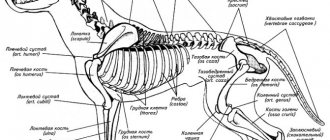Violation of the anatomical integrity of the bone structure and adjacent tissues (muscles, ligaments, tendons, nerves and blood vessels) or fracture occurs under the influence of external force or some pathology. Treatment includes non-surgical methods and osteosynthesis, depending on the type and complexity of the fracture. Quick recovery from injury largely depends on caring for your sick pet.
Types of fractures in cats
Due to a fracture, the anatomical configuration of the bone changes: it is damaged and loses motor activity (in whole or in part). Veterinarians distinguish between acquired and congenital fractures. The latter account for no more than 5% of all requests. Congenital lesions are diagnosed in kittens. They usually occur when pressure is applied to the abdominal cavity of a pregnant cat (for example, due to careless handling of the pet, blows), as well as due to intrauterine anomalies. Acquired fractures are observed in newborn kittens (for example, as a result of obstetrics), as well as in adult cats. They are usually caused by falling from a great height or being hit by heavy objects.
Classification of fractures in cats: • Open . They pose the greatest danger, since the wound can become infected with pathogenic microorganisms. • Closed . They differ in that the bone is broken, but is under the skin, so it is not visible. The paws can break at one or several points at once (multiple fracture). The latter usually occurs when a pet falls out of the window of a multi-story building or a tall tree, especially when the animal hits branches, ropes and other obstacles when falling.
What types of damage are there?
Most often in animals, it is the radius bone that is damaged.
Among fractures, the most common injury is the radius bone, since the front legs bear the main load during landing. Varieties:
- Injury. It is characterized by compression of the soft tissues of the paw if the cat hits it, but the bone structures remain unharmed.
- Dislocations. The articular head is displaced from the articular capsule. The condition is often combined with a fracture.
- Closed injury. The bone is broken without breaking the integrity of the skin.
- Open fracture. Bone structures break and fragments pierce the skin.
In addition, fractures are of the following types:
- Fragmentation. The bone is crushed into several fragments.
- Multiple. The bone structure is broken in several places.
- Single. The paw is only broken in one place.
Causes
If we are talking about a congenital fracture, then its cause is strong contraction of the uterus during childbirth or rapid (inaccurate) extraction of the fetus during cesarean section. We strongly do not recommend giving birth to a cat yourself - contact a specialist to avoid unwanted consequences. Common causes of fractures in adult pets: • bruises, • blows, • pinched paws and subsequent improper release, • road accident injuries, • falls, • accidental household injuries. In cats, pathologies of the musculoskeletal system can be diagnosed, in which spontaneous fractures are possible even with slight pressure on a bone that has already lost its anatomical strength.
How to distinguish a fracture from a bruise or dislocation of a paw
Simple fractures are treated with conservative methods. These include pain relief and elimination of pain shock. Immobilization using splints and splints is used to restore damaged bone. For pain relief, drugs such as Traumeel and Butomidor are used. Splints and braces are removed only after the veterinarian gives permission to do so.
For complex types of fractures, surgery cannot be avoided. Osteosynthesis involves removing small bone fragments and realigning large ones. Surgical intervention using fixing metal structures should be carried out immediately after diagnosing a fracture.
Pins, plates and spokes made from a special alloy with titanium remain in the animal’s body for life.
The regeneration process will be helped to speed up by drugs that improve osteosynthesis, vitamin therapy, and physiotherapy.
If a cat has been diagnosed with a dislocation, treatment includes pain relief and realignment of the injured limb, followed by the application of a fixing bandage. In severe cases, surgery is indicated.
As for the prognosis for fractures and dislocations, in most cases it is favorable. The only exceptions are spinal fractures with damage to the spinal cord structure. If the fracture causes rupture of large vessels of the limb or peripheral nerves, then for the cat this ends in the loss of the limb.
Dislocations should not be underestimated: if the damage is not treated, it can subsequently lead to complex muscle deformations and destruction of articular surfaces. As a result, the cat will limp for the rest of its life.
Not in all cases the injury can result in a fracture. You need to know how to distinguish a fracture in a cat from a bruise or dislocation of a paw:
- When the paw is unnaturally twisted at an angle, there is no need to think - this is a 100% fracture, and a severe one at that.
- Torn skin and pieces of bone in the wound leave no room for thought - this is an open fracture.
- Swelling is typical for severe bruises, dislocations, and fractures. But only in the latter case can the cat’s paw swell to the size of a good zucchini.
- Upon palpation, you can feel how the ends of the broken bone move under your fingers. Carefully! A cat with such a diagnosis can die from painful shock!
- Unlike dislocations, when the limb hangs like a whip, with fractures the paw still retains a certain rigidity.
- With bruises (even severe ones), the cat can still step on its paw. In case of fractures and dislocations, he will not do this. In the first case, it hurts, in the second, the limb, dislocated from the joint, simply cannot support the weight of the animal.
Signs of a broken paw
An obvious sign of a broken paw in a cat is its behavior. She avoids stepping on the injured paw. If the fracture is open, then you will immediately see the damage and be able to take action. With a closed fracture, severe swelling appears in its place. Other signs that will help you identify a fracture: • inability to straighten the leg completely, • acute pain when palpating the damaged area, • unnatural mobility of the bones, • change in the anatomical shape of the bone, • walking on three legs. Note! If two or more paws are damaged, the animal will not be able to get up.
How will the doctor act?
First, the doctor will numb your animal. He then examines the cat and its broken leg. This is of particular importance for those patients who were injured by a car or fell from a height, because in addition to the problems that are obvious to the owner - a fracture - the cat may have a chest or abdominal injury. These injuries to a cat may not be noticeable, but require significantly more urgent and complex treatment than a fracture. After the examination, your veterinarian will take an X-ray of your cat's broken leg to evaluate the fracture and plan treatment, as well as further diagnose other injuries, if any. Sometimes sedation is required for x-rays.
As a rule, 99% of fractures of the front and hind legs in cats require treatment with surgery - osteosynthesis. This operation is performed as planned, often 3-5 days after the fracture. This period is explained by the physiological characteristics of the body: during an injury, massive hemorrhage occurs in the area of the fracture, and then this blood and parts of the destroyed tissue that fall into it become so-called “osteogenic elements” - substances that stimulate the bone to heal. If surgery is performed immediately after a fracture, the entire contents of the hematoma will spill out, and healing will be slower and more difficult. Another difficulty for manipulating bone fragments is created by swelling of the soft tissues, which subsides precisely by 3-5 days after the fracture. The exception is open fractures - due to the open gate for infection, they require urgent (within 24 hours) surgery.
Before surgery, the doctor will fix the broken paw with a bandage.
Of course, fractures of the jaw, pelvis, and spine require a special approach in cats—we’ll talk about them a little later.
Your actions
What to do if your cat has a broken paw? If you think that the bone is damaged, provide the animal with complete rest: as carefully as possible, transfer it to a comfortable bed (soft blanket) or into a carrier with a comfortable bottom. If bleeding is observed, apply a tight tourniquet. However, do not squeeze the vessels too much, otherwise necrosis (the process of tissue death) caused by lack of nutrition will begin. Apply a bandage, splint, or bandage. You should not give your pet painkillers or other medications (for example, antipyretics) yourself - this can worsen the cat’s condition. The best solution is to immediately take your pet to a veterinary clinic in Moscow!
What can you do yourself to help your cat?
The main task of first aid for a fracture in a cat is to understand whether there is bleeding and stop it. As a rule, severe bleeding accompanies open fractures, fractures caused by bites and gunshot fractures. To stop bleeding, it is better to use a pressure bandage, which is effective in 90% of cases. We recommend a pack of sterile gauze pads to stop bleeding. If they are not nearby, then you can use a handkerchief, mitten, piece of fabric, or feminine pad. Sterility is not so important now, the main thing is to stop the bleeding, which is life-threatening for the cat. A swab made of napkins or other fabric should be placed directly over the source of bleeding and bandaged quite tightly - with gauze or an elastic bandage, or a piece of fabric. Now - hurry up to the veterinary clinic. Our doctors recommend not wasting time calling a doctor to your home in such a situation, because full care for a fracture can only be provided to a cat in a clinic setting.
If there is no bleeding, but you see that the cat most likely has a broken front or back leg and it is “dangling around a lot,” you can immobilize it in the position it is in. Don’t try to “set” the fracture yourself! This is very painful. If handled improperly, the sharp edges of the bone can damage blood vessels and nerves, causing pain and additional injury to the cat. You just need to ensure that the cat's paw remains motionless while transporting the animal to the clinic. If you are in doubt or afraid, it is better not to do anything and take your cat to a veterinary clinic as quickly as possible.
Diagnosis of a fracture
The initial stage of treatment is diagnosis. The veterinarian examines and gently palpates the damaged area, then sends the pet for an x-ray examination. It allows you to make a diagnosis with 100% confidence, as well as establish the nature of the fracture (chip, crack, fracture). If necessary (for example, if other diseases are suspected), the specialist prescribes additional laboratory tests - general tests: • blood, • urine, • feces. Based on the diagnostic results, the veterinarian prescribes treatment.
What you need to pay special attention to
It is interesting that you should not pay special attention to whether or not to hold the paw on the weight. The animal will do this both in case of a fracture and a dislocation, and in the presence of a severe bruise, it will not be able to fully use the limb.
With “branch” damage to the bone, the pet may step on the paw, which completely misleads the owners. They believe that swelling and soreness are just a simple bruise (it happens that veterinarians themselves make such mistakes).
To prevent this from happening, it is necessary to use several diagnostic techniques at once:
- Radiographs. X-rays are the most common way to diagnose the presence of a fracture. But it’s still worth remembering that some of their varieties resemble a thin line in the picture (especially in a kitten), so the analysis of the results should be entrusted to the most experienced radiologist. If you have any doubts about the reliability of the analysis, it will not hurt to duplicate the image.
- Blood tests. They are mandatory for older animals in which osteoporosis or a cancerous cause of fractures is suspected.
- Ultrasound of the internal cavities of the body. It is possible that damage to the limbs is the least of all the animal’s problems. In addition, fractures of the distal bones of the pelvic and thoracic girdles are often accompanied by damage to the spine. And this is already fraught with paralysis and even death. So when diagnosing, you need to check everything, as this can later save you from many very unpleasant surprises.
We suggest you read: Treatment of bloody diarrhea and vomiting in cats
Conservative therapy
Conservative treatment is prescribed for closed and uncomplicated fractures. The first stage is local anesthesia, the second is the extraction of bone fragments. The procedure is completed by applying a plaster cast to prevent disturbance to the damaged area. The veterinarian makes sure that the bandage secures all nearby joints, but does not put pressure on the limb or internal organs. A veterinary clinic in Moscow uses lightweight polymer gypsum plates, applied for a period of 15 to 40 days. To prevent inflammation, your doctor may prescribe corticosteroids. If necessary, painkillers and sedatives are prescribed. They will help the animal’s body recover faster and also promote accelerated bone tissue growth. Additionally, physiotherapeutic techniques can be used to ensure accelerated recovery of the pet. On average, about 75-80% of cats recover with non-surgical treatment and without going to a surgeon.
Surgical treatment
In case of complicated fractures (for example, splinter and depressed fractures), urgent assistance from a veterinary surgeon is required. He operates on the animal to connect the bone fragments and fix them securely. After fusion of the bone tissue, all material used for connection (threads, pins) is removed. Among the main methods of osteosynthesis: • Intramedullary . The bone fragments are connected using a reliable fixation rod, which is inserted into the intramedullary canal. This technique is successfully used in more than 35% of fracture presentations; • Extramedullary (lamellar) . Plates are placed over the damaged bone and then secured with screws. The main advantage of the method is strong fixation. It is usually used for comminuted as well as oblique fractures; • Extrafocal . External fixation is used using pins: they are fixed above and below the fracture. Its advantage is minimal trauma and the possibility of physical activity, which reduces the likelihood of muscle atrophy. The choice of surgical intervention method depends on the condition of the pet and the nature of the leg fracture. Please note that recovery after surgery takes 5 to 7 weeks.
First aid
In case of an open form of injury, first of all, it is necessary to remove protruding foreign objects, dirt and sharp bone fragments from the wound channel, and stop the bleeding. This can be done by pressing a clean cloth wrapped around your finger against the wound.
If a large vessel on the hind limb is damaged, the bleeding is stopped by squeezing the artery on the inside of the thigh. If bleeding and damage to the front paw are detected, the artery under the elbow joint is clamped. The wound must be treated with an antiseptic solution: hydrogen peroxide, chlorhexidine, miramistin, potassium permanganate solution.
Fixing the limb
After treating the wound and stopping the bleeding, the owner should begin fixing the damaged limb. A small board, a wide ruler, or a plastic panel will be suitable as a tire. The fixation device should be slightly longer than the limb itself.
Scheme for bandaging a cat's paw
The damaged paw should be secured to the splint using a bandage, belt, belt, or tape. The bandage should be tight, but not squeezing the blood vessels. Bandaging is not carried out in the area of an open wound.
Pain reliever for injury
Veterinary experts do not recommend that owners independently use painkillers for fractures. This is due to the fact that without feeling pain, the animal can cause even more harm to itself, aggravating its situation. Pain relief can smooth out the clinical picture of the injury. In addition, the pet will need sedation for X-ray examinations, and pre-administration of an analgesic will adversely affect the cat's health.
Arranging transportation to the clinic
After providing competent first aid, a sick pet must be transported to a specialized facility as quickly as possible. For this purpose, thick cardboard, a piece of plywood, boards, a panel from a car, etc. will be suitable in the field. It is important that the surface is smooth and hard.
Transportation will have to be carried out in a supine position. The sick animal should be secured with straps or rope to a hard surface at hand. This needs to be done in the area of the shoulder blades and pelvis. The cat should be transported in the back seat of the car.
Recovery period
After the operation, the pet is under supervision in the hospital for 4-6 hours. This allows doctors to monitor his condition. Then treatment of the sutures is prescribed, and painkillers are prescribed for a course of up to 7-10 days. It is recommended to limit your pet's mobility for 4-6 weeks. If you walk your cat or let it go outside on its own, then leave it at home during the rehabilitation period. If possible, place the animal in a large cage. 3-4 weeks after surgery or casting, if conservative treatment is prescribed, you must contact the veterinary clinic again and take an x-ray. This will allow you to evaluate the speed and correctness of bone fusion. You can quickly restore the motor function of a damaged paw with regular manual massage. Ask your doctor about the technique for performing it. Massage improves blood circulation and prevents muscle atrophy. The next important point is diet. We recommend switching your pet to an easily digestible and balanced diet for the entire rehabilitation period. It is prohibited to prescribe multivitamin supplements on your own - consult with a specialist and find out which vitamins and minerals will help your pet’s body recover faster.











